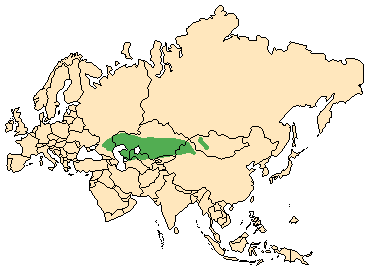![]() Return
to Artiodactyla
Return
to Artiodactyla
Classification
|
 Saiga tatarica
Saiga tatarica
Saiga antelope
![]()
Taxonomy
 |
 |
 |
Click on the pictures above for a larger view of the
photographs
|
||
General Characteristics
Body Length: 108-146 cm / 3.6-4.8 ft.
Shoulder Height: 60-80 cm / 2-2.6 ft.
Tail Length: 6-13 cm / 2.4-5.2 in.
Weight: 21-51 kg / 46-112 lb.The coat is composed of a wooly underlayer and a coarse set of bristly hairs which protect the saiga antelope from the elements. The cinnamon-buff summer coat is comparatively sparse compared to the virtually white winter coat, which may be up to twice as long and 70 percent thicker. The underparts, including the underside of the tail, are always light. There is a small mane on the underside of the neck. Only one word can describe the face of the saiga - bulging. The most notable feature is the inflatable, humped nose which looks similar to that of tapirs or dik-diks. This fleshy proboscis has a wide range of mobility and a unique internal structure, with convoluted bones, and numerous hairs and mucous-secreting glands. The large nose is functional throughout the year, filtering out airborne dust during the summer migrations and heating the air before it reaches the lungs during the icy winters. The eyes of the saiga, when viewed from straight on, appear to stand out on small, bony protrusions. The thick body is supported by spindly legs. Males alone bear the semi-translucent, wax-coloured horns which grow 20-25 cm / 8-10 inches long. Almost vertical, the slightly lyrate horns are ringed on their lower two-thirds.
Ontogeny and Reproduction
Gestation Period: 140 days.
Young per Birth: In the first year 1, subsequently 2 is normal.
Weaning: At 3-4 months.
Sexual Maturity: Females at 8 months, males at 20 months.
Life span: 6-10 years.Births occur at the end of March and beginning of April, with all the females in a herd dropping their calves within a few days. After birth, the young lie concealed and immobile for the first three days, moving around, bleating, and eating a bit of green food from the fourth day of life.
Ecology and Behavior
The saiga antelope is active mostly during the day, although it may rest at midday. A nomadic species, saiga have no fixed home ranges and usually walk several dozen kilometers in a given day. The saiga is an extremely good runner, and is able to reach speeds up to 80 kmph / 48 mph. Populations undertake seasonal migrations, moving north in the spring to the summer grazing grounds, and returning southward in the fall. Covering 80-120 km / 48-72 miles per day, saiga march with their heads low to the ground, with their specialized noses filtering out the stirred up dust from the air. The rut begins in the wintering grounds, with mature males becoming territorial and attempting to gather a harem of females. Fierce fights break out among rival males, which often result in death. Due to the extreme demands of the rut, during severe winters sexually mature males have a high likelihood of dying - up to 97% will not survive. At the end of April, surviving males start off the seasonal spring migration, forming herds of 10-2,000 animals and setting out northwards. In the meantime, females wander in huge herds to a suitable birthing ground, where they all drop their calves within about a week of each other. Just 8-10 days after the peak in births, the females and new babies set off after the males, in congregations exceeding 100,000 animals. Once the migration is finished, the streams of animals break up and disperse in smaller herds. The large groups reform in the autumn, and the saiga move en masse back south. A timid species, the saiga can be easily startled, causing immediate flight, even in the huge migrating herds. While the sense of hearing is poorly developed in the saiga, their sense of sight is acute and they are able to see danger up to a kilometer / 0.6 miles away. Under favourable conditions, saiga will visit a water hole twice every day.Family group: Variable - streams of over 200,000 animals occur in the spring migrations, while in summer herds of 30-40 animals form. The large migratory herds form again in autumn, while in winter the territorial males gather harems of 5-15 females.
Diet: Herbs, lichens, plants containing salt.
Main Predators: Wolf, fox, birds of prey.
Distribution
Steppes and semideserts of Russia and Mongolia.

Range Map (Redrawn from Sokolov, 1974)
Conservation Status
As a species, the saiga is classified as vulnerable by the IUCN (1996). S. t. tatarica is also classified as vulnerable, while S. t. mongolica is considered endangered. Saiga antelope have been ruthlessly hunted for their horns, which are believed to be aphrodisiacs.
Remarks
This strange ungulate proved to be a problem for early taxonomists, and its true phylogenetic position is still debated. When it was first named in 1766, the saiga was placed in the genus Capra along with goats, later being moved to the genus Antilope, and then to Gazella. The saiga is now thought to occupy an intermediary stage between sheep and antelopes. Saiga is the Russian name for this antelope. Tatary is a region in part of European Russia; -icus (Latin) suffix meaning belonging to.
Literature Cited
Nowak, R. M. [editor]. 1991. Walker's Mammals of the World (Fifth Edition). Baltimore: The Johns Hopkins University Press.Sokolov, V. E. 1974. Saiga tatarica. Mammalian Species; (38): 1-4.
Walther, F. R. 1990. Saiga-Like Antelopes. In Grzimek's Encyclopedia of Mammals. Edited by S. P. Parker. New York: McGraw-Hill. Volume 5, pp. 485-494.
Wilson, D. E., and D. M. Reeder [editors]. 1993. Mammal Species of the World (Second Edition). Washington: Smithsonian Institution Press. Available online at http://nmnhwww.si.edu/msw/
Return to Artiodactyla

![]()
© Brent Huffman, www.ultimateungulate.com |
|
|